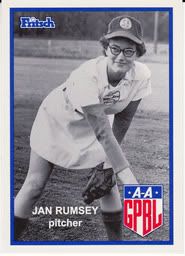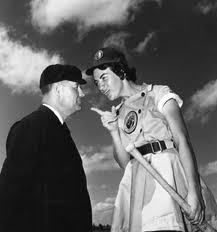“A League of their Own”
The All-American Girls Baseball League was formed in 1942 by Philip K. Wrigley of Wrigley Gum and Chicago Cubs fame. Wrigley feared that due to World War II he would soon find his ball park sitting empty with all of his players off fighting. An empty ballpark doesn’t generate any revenue, so Wrigley formed a committee that proposed the idea of creating women’s baseball league. Wrigley’s committee originally pitched the idea to other major league owners, with the proposal that the women would play games on days that the men were not, doing so in order to maximize the use of their stadiums. However, this idea of a women’s baseball league did not draw much interest from the other owners, and Wrigley was left to continue on his own selecting four cities without Major League baseball teams near Chicago to be the original host cities.
These original cities and teams were: Kenosha Comets, Racine Belles, Rockford Peaches, and the South Bend Blue Sox. Over the Leagues history it fielded as many as 10 teams for the 1948 season, though the league expanded and contracted often in its short history. Only two of the original four teams lasted long enough to play in all twelve seasons of the league - these teams were the Rockford Peaches and the South Bend Blue Sox. Even though all of the teams were located around the Great Lakes region, the players came from near and far. When the league was formed scouts were sent out to major softball leagues around the country and Canada, as well as having try-outs held in major cities around the United States. After this initial round of scouting, 280 girls were brought to a final try-out at Wrigley Field in Chicago where the top sixty were selected to be the first professional women baseball players. The initial season of league play featured players from twenty-six states and five Canadian provinces.
One of the major fears Mr. Wrigley had when forming the league was that the girls would come off as too masculine, making fans unable embrace the players. To combat those image concerns, Wrigley sent players to “Charm School” to teach his players etiquette and guidelines to become a vision of feminine beauty on and off the field. The uniforms for the All-American Girls Baseball League were also designed to be very feminine and stylish, created by the team of Mrs. Wrigley, Otis Shepard who was the art designer for Wrigley’s Gum, and Ann Harnett. Ann Harnett, a softball star from Chicago, was the first player signed to the league and became the model for the league’s uniforms.
When the All-American Girls started playing baseball in 1943, the rules and strategy were a combination between the baseball played in men’s professional leagues and softball. The major differences to be seen were: distances between the plate and pitching mound, distances between the bases, styles of pitching, and the size of the ball. Throughout the years these differences became less pronounced as the league continued to evolve to more closely resemble that of the Major League.
A Shrinking Target:
The size of the ball used by the league shrunk throughout the years. The All American Girls Professional Baseball League started out using a twelve inch circumference ball which was similar to the size of a softball and ended up using a nine inch circumference ball. This nine inch ball was the same size used by their male counterparts in the major leagues.
Pitching Styles:
When the girls took to the field in 1943, only underhanded pitching was permitted, in what was basically an early form of fast-pitch softball. As early as 1946 the league began allowing side armed pitching and in 1948 the rules allowed the girls to pitch overhand just like the men.
Running the Bases and Moving the Mound:
The distance between the bases grew from only sixty-five feet apart in 1943 until they were eighty-five feet in 1954; this was just five feet shy of the 90 foot distance used by the men. The gap between the pitcher’s mound and home plate also grew during the leagues history, starting only forty feet away the home plate and moving back several times until the girls were pitching sixty feet from the plate.
The All-American Girls baseball league ran until 1954, when dwindling attendance spelled the end for the league. With live broadcast of major league baseball games on television becoming more and more popular, fewer people came out to watch the girls play. The league had contracted back to only four teams in this last year with the Kalamazoo Lassies winning the final championship. However, the league lived on through its players’ memories, hosting many reunions as well as being featured in the hit movie “A League of their Own.”
The All-American Girls Professional Baseball League’s Decatur County connection is Janet Rumsey, a pitcher for the South Bend Blue Sox from Burney. Janet played four years in the league (1951-54) and has the distinction of being named the pitching champ of 1954 as well as pitching the league’s last no-hitter.
The Historical Society Museum invites you to come and check out our display of the league which includes: uniforms, a “Charm School” guidebook, scrapbooks, photographs as well as a large collection of items provided by Janet Rumsey’s family. We will also be hosting a special event on September 18th at 1:30 at the historical society museum with a panel of former players and an umpire from the All-American Girls Baseball League.




No comments:
Post a Comment